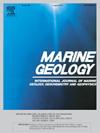Clinoform architecture influenced by salt tectonics and Quaternary Sea level changes: The Acheloos delta complex, Gulf of Patras, Greece
IF 2.2
3区 地球科学
Q2 GEOSCIENCES, MULTIDISCIPLINARY
引用次数: 0
Abstract
This study focuses on the evolution of the Acheloos river-dominated delta in western Greece. It is an area with limited published data, that serves as a link between the well-studied rift basin of the Gulf of Corinth and the active Kephalonia Transform Fault. The examination of a newly acquired 3D seismic cube and vintage well data in this area offers a rare opportunity to: i) develop a stratigraphic scheme for the evolution of river-dominated deltas in restricted basins influenced by salt tectonics, which can be applied as an analogue to similar deltas worldwide, and ii) re-evaluate the deformation style of the study area and challenge the widely accepted concept of its tectonic behavior as a rigid block.
Detailed 3D seismic stratigraphy and well data revealed eleven progradational packages. These are attributed to the Acheloos activity during Pleistocene and exhibit distinctive spatial variation. Thickness distribution and trajectory analysis show that the delta developed in three stages: (i) poorly developed progradational units in a weakly subsiding basin, (ii) retrogradational delta units in a strongly subsiding basin and (iii) stabilization of the accommodation space and gradual basin infill through progradational units.
Although the study area has been considered a rigid block, stratigraphic analysis revealed multiple subsidence events linked to the structural history of the basin. Additionally, seismic data reveal that salt tectonics have a significant impact on its evolution, affecting the locus of the depocenters and the subsidence rates. The deformation of the underlying strata shows that the salt diapiric activity intensified from 435 ka to present. This can either be attributed to the differential loading due to the continuous deltaic sedimentation and/or to the structural activity within the study area. Notably, the paroxysmal phase of salt tectonics occurs right after a large subsidence of the area of interest between 860 and 550 ka.
受盐构造和第四纪海平面变化影响的斜形构造:希腊帕特雷湾Acheloos三角洲复合体
本研究的重点是希腊西部以Acheloos河为主的三角洲的演变。这是一个数据有限的地区,它是连接已经得到充分研究的科林斯湾裂谷盆地和活跃的凯法隆转换断层的纽带。对该地区新获得的三维地震立方体和古井数据的研究提供了一个难得的机会:1)为受盐构造影响的局限盆地中河流主导三角洲的演化制定地层方案,这可以作为世界上类似三角洲的类比应用;2)重新评估研究地区的变形风格,并挑战其构造行为为刚性块的广泛接受的概念。详细的三维地震地层和井资料揭示了11个递进层。这是更新世Acheloos活动的结果,具有明显的空间差异。厚度分布和轨迹分析表明,三角洲发育经历了3个阶段:(1)弱沉降盆地的前积单元发育不良;(2)强沉降盆地的退积三角洲单元;(3)通过前积单元稳定可容纳空间并逐渐填满盆地。虽然研究区一直被认为是一个刚性块体,但地层分析揭示了与盆地构造历史有关的多次沉降事件。此外,地震资料显示,盐构造对其演化有重要影响,影响沉积中心的位置和沉降速率。下伏地层变形表明,435 ka至今盐底辟活动加剧。这可能是由于连续的三角洲沉积和/或研究区内的构造活动造成的差异负荷。值得注意的是,盐构造的阵发性阶段发生在860 - 550 ka之间的大沉降之后。
本文章由计算机程序翻译,如有差异,请以英文原文为准。
求助全文
约1分钟内获得全文
求助全文
来源期刊

Marine Geology
地学-地球科学综合
CiteScore
6.10
自引率
6.90%
发文量
175
审稿时长
21.9 weeks
期刊介绍:
Marine Geology is the premier international journal on marine geological processes in the broadest sense. We seek papers that are comprehensive, interdisciplinary and synthetic that will be lasting contributions to the field. Although most papers are based on regional studies, they must demonstrate new findings of international significance. We accept papers on subjects as diverse as seafloor hydrothermal systems, beach dynamics, early diagenesis, microbiological studies in sediments, palaeoclimate studies and geophysical studies of the seabed. We encourage papers that address emerging new fields, for example the influence of anthropogenic processes on coastal/marine geology and coastal/marine geoarchaeology. We insist that the papers are concerned with the marine realm and that they deal with geology: with rocks, sediments, and physical and chemical processes affecting them. Papers should address scientific hypotheses: highly descriptive data compilations or papers that deal only with marine management and risk assessment should be submitted to other journals. Papers on laboratory or modelling studies must demonstrate direct relevance to marine processes or deposits. The primary criteria for acceptance of papers is that the science is of high quality, novel, significant, and of broad international interest.
 求助内容:
求助内容: 应助结果提醒方式:
应助结果提醒方式:


